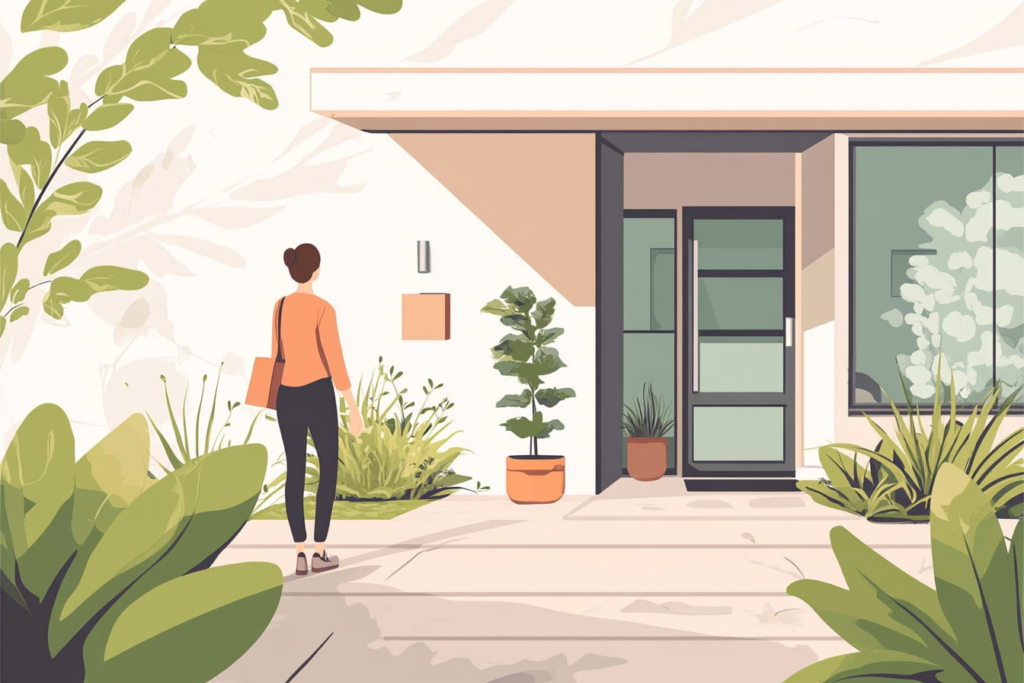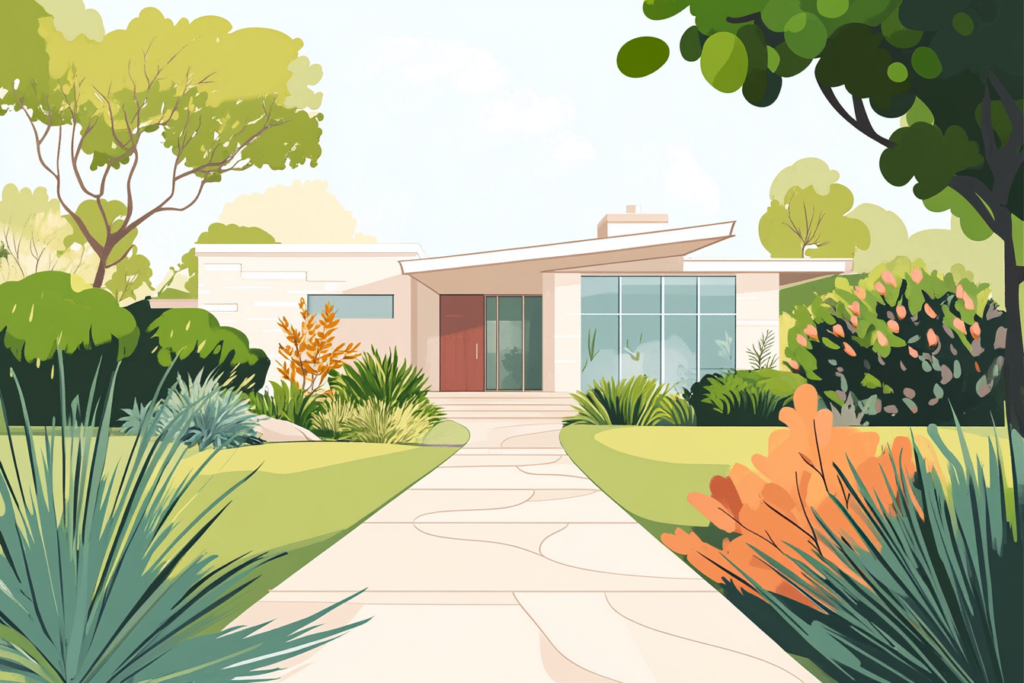When considering home security, most homeowners focus on locks, alarm systems, and cameras. While these measures are essential, your landscaping plays a surprisingly significant role in either deterring or inadvertently assisting potential intruders. Thoughtful landscape design can enhance your home’s security without sacrificing beauty or turning your property into a fortress.
According to FBI statistics, a burglary occurs approximately every 30 seconds in the United States, and the average loss per burglary is around $2,400. Even more concerning, about 70% of break-ins are residential. What many homeowners don’t realize is that their beautiful landscaping might actually be helping intruders stay hidden while attempting to access their homes.
We’ll share how you can transform your yard from a potential burglar’s ally into your home’s first line of defense. We’ll cover practical landscaping strategies that balance aesthetics with security, using the concept of Crime Prevention Through Environmental Design (CPTED).
Understanding How Burglars See Your Yard
Before implementing security-focused landscaping, it’s important to understand how intruders view your property. Professional burglars typically look for:
- Cover and concealment: Dense shrubs, trees, or structures that block visibility from the street or neighbors
- Easy access points: Unsecured gates, climbing aids like trellises near windows, or trees that provide access to second-story windows
- Signs of absence: Overgrown lawns, piled-up mail, or dark houses
- Quick escape routes: Multiple entry/exit points without obstacles
- Minimal lighting: Dark areas around entry points
By thinking like a burglar, you can identify vulnerable areas in your current landscaping and address them effectively.
The 3-Foot/8-Foot Rule

One of the most practical guidelines for security-focused landscaping is the 3-foot/8-foot rule. This principle suggests:
- Keep shrubs and hedges around windows and doors trimmed to no more than 3 feet in height
Strategic Plant Selection for Security
The plants you pick can significantly impact your home’s security. Here’s how to select and position plants strategically:
Barrier Plants (Natural Deterrents)
Some plants naturally discourage trespassers without making your yard look unwelcoming. Consider incorporating:
- Thorny or prickly plants: Roses, barberry, holly, and pyracantha create beautiful but effective barriers
- Dense, hard-to-penetrate shrubs: Juniper, boxwood, or bamboo, can form natural boundaries
- Noisy ground covers: Gravel or decorative stones that make noise when walked upon
Place these barrier plants strategically:
- Under windows
- Along property lines
- Near fences that could be climbed
- Along the perimeter of your yard
What to Avoid
Certain plants and landscaping elements can unintentionally help intruders:
- Large shrubs near windows or doors: These provide hiding spots
- Trees with low branches near second-story windows: These can serve as ladders
- Dense vegetation that blocks sightlines to entryways: This creates blind spots
- Tall plants that block security lighting: These create shadows where intruders can hide
Fencing and Boundaries: Finding the Balance
Fencing plays a dual role in home security. While it establishes a psychological and physical boundary, the wrong type of fence can actually reduce security by blocking visibility or providing climbing opportunities.
Effective Security Fencing
- Height considerations: Fences under 3 feet maintain visibility while marking boundaries; fences over 6 feet provide privacy but should be designed to avoid creating hiding places
- Material choices: Ornamental aluminum or wrought iron fencing offers security without sacrificing visibility
- See-through elements: Consider fences with gaps or transparent sections that maintain sightlines
- Gate security: Install quality locks on all gates and ensure hinges are tamper-resistant
Natural Boundaries
If traditional fencing doesn’t fit your aesthetic, consider natural boundaries:
- Hedge rows: Strategically placed but properly maintained
- Decorative stone walls: Low enough to see over, but defining property lines
- Mixed plantings: Layered plantings that create depth without dense cover
Strategic Lighting: Illuminating for Safety
Proper lighting eliminates shadows where intruders might hide and signals that your home is well-maintained and monitored.
Effective Security Lighting Strategies
- Entry points: Illuminate all doors, windows, and other potential entry points
- Pathways: Light walkways and driveways to eliminate hiding spots
- Layered lighting: Combine ambient, flood, and accent lighting for comprehensive coverage
- Motion-activated lighting: Install motion sensors in key areas to surprise potential intruders
- Low-voltage options: These provide security while being energy-efficient
- Smart lighting systems: Program lights to create the appearance of occupancy when you’re away
Lighting Placement Tips
- Position lights to avoid creating harsh shadows that could serve as hiding spots
- Install fixtures high enough to prevent tampering
- Ensure all dark corners and blind spots around your home are illuminated
- Consider solar options for areas far from electrical outlets
- Use timers or smart systems to ensure consistency
Hardscaping Elements That Enhance Security
Beyond plants and lighting, hardscaping features can significantly improve your home’s security while enhancing its appearance.
Driveways and Walkways
- Surface materials: Gravel or loose stone creates noise when walked upon
- Design approaches: Curved pathways improve visibility and slow approach
- Positioning: Design walkways to be visible from the house and street
Decorative Features
- Water features: Ponds or fountains can create natural boundaries
- Retaining walls: Low walls can define spaces without creating hiding spots
- Artistic elements: Decorative features that enhance security (e.g., sculptural pieces that limit access to windows)
Maintaining Your Security Landscape
Even the best security-focused landscape will fail if not properly maintained. Regular maintenance:
- Shows occupancy: A well-maintained yard signals that someone is regularly present
- Preserves security features: Keeps important sightlines clear and barrier plants effective
- Prevents deterioration: Ensures lighting, fences, and other elements remain functional
Maintenance Checklist
- Trim shrubs and hedges regularly, especially near windows and doors
- Prune tree branches away from the house and up from the ground
- Replace burned-out bulbs in outdoor lighting promptly
- Repair fences, gates, and other boundary markers as needed
- Remove yard debris that could provide hiding places
- Keep lawn mowed, especially when traveling
Tech Integration: Smart Landscaping
Modern landscape security can integrate with smart home technology for enhanced protection:
- Irrigation systems: Smart sprinklers that can be activated remotely to deter trespassers
- Outdoor cameras: Positioned to monitor entry points without being easily disabled
- Smart lighting: Systems that create realistic occupancy patterns
- Motion detectors: Discreetly placed throughout the landscape
Seasonal Considerations
Different seasons present different security challenges for your landscape:
Summer
- Keep growth in check during peak growing season
- Consider how dense foliage might create new hiding spots
- Ensure vacation maintenance while traveling
Fall
- Remove leaf accumulation that might signal absence
- Check lighting as days get shorter
- Prepare security measures for earlier nightfall
Winter
- Maintain clear paths despite snow (showing occupancy)
- Adjust lighting timers for seasonal darkness
- Consider how dormant plants affect visibility
Spring
- Evaluate winter damage to security features
- Plan new security-enhancing plantings
- Refresh lighting and boundaries
Community Approaches to Landscape Security
Individual efforts are more effective when coordinated with neighbors:
- Neighborhood watch programs: Formalize observation and reporting
- Shared visibility: Design landscapes that help neighbors see your entrances
- Consistent standards: Encourage community-wide security landscaping practices
Professional Help vs. DIY Approach
Depending on your skills and property size, you might consider:
- Professional security consultation: Having an expert assess your specific vulnerabilities
- Landscape designer collaboration: Working with a professional who understands security principles
- DIY assessment: Walking your property regularly to identify and address issues
- Phased implementation: Addressing highest-risk areas first, then developing a long-term plan
Use Landscape as Your First Defense
Your yard doesn’t have to choose between being beautiful and being secure. With thoughtful planning and maintenance, your landscape can be your home’s first and most attractive line of defense against intruders.
By implementing the principles outlined in this guide, you’ll create an environment that naturally deters criminal activity while enhancing your home’s curb appeal and your enjoyment of outdoor spaces.
Remember that landscape security is about creating an environment where intruders feel exposed and uncomfortable while you and your family feel protected and at ease. The best security landscape is one that works so naturally and effectively that its protective elements go virtually unnoticed—except by those who might have bad intentions.
Take time to evaluate your current landscaping with security in mind, and consider which changes might offer the greatest benefits for your specific property. Start with the most vulnerable areas, and gradually transform your yard from a potential burglar’s ally into a beautiful but formidable defender of your home.
You might also be interested in: How to Prevent Home Break-Ins: 7 Overlooked Security Tips




